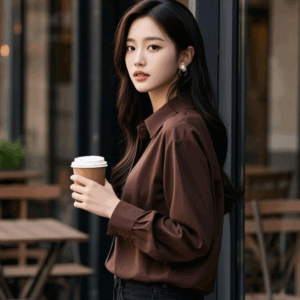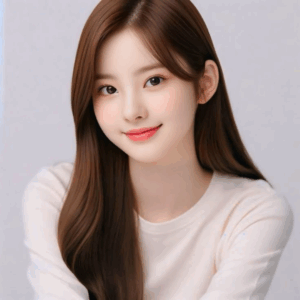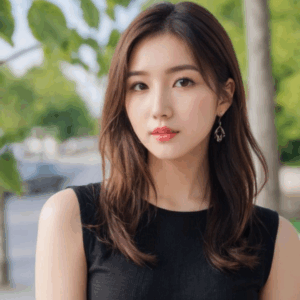Smart & Stunning: AI-Created Faces of Modern Women captivates readers with a fascinating exploration of how AI technology is revolutionizing the portrayal of women in today's society. This introductory passage sets the stage for an enlightening discussion that delves into the intricacies of AI-generated faces and their impact on beauty standards.
Introduction to AI-Created Faces of Modern Women
AI-created faces refer to digital images of women that are generated using artificial intelligence technology. These images are becoming increasingly realistic and are playing a significant role in shaping perceptions of beauty and identity in modern society.
The Role of AI Technology in Generating Realistic Images of Women
AI technology, particularly machine learning algorithms, is used to analyze vast amounts of data on facial features, skin tones, and expressions to create highly detailed and lifelike images of women. By continuously improving the algorithms, AI can generate faces that are indistinguishable from real photographs.
How AI-Created Faces Are Changing the Perception of Beauty Standards
AI-created faces challenge traditional beauty standards by showcasing a diverse range of features, skin tones, and styles that go beyond conventional ideals. This diversity promotes inclusivity and celebrates individual uniqueness, redefining what is considered beautiful in the digital age.
Technology Behind AI-Created Faces

AI-generated faces are created using advanced algorithms that analyze and synthesize facial features to produce realistic images of non-existent individuals. These algorithms are trained on large datasets of human faces to learn patterns, structures, and variations in facial characteristics. Different AI models are utilized in this process, each with its own approach and level of effectiveness in generating lifelike faces.
Algorithms Used in Creating AI-Generated Faces
- Generative Adversarial Networks (GANs): GANs consist of two neural networks - a generator and a discriminator - that work in tandem to create high-quality images. The generator generates images, while the discriminator evaluates them for realism. This iterative process results in the generation of increasingly realistic faces.
- Variational Autoencoders (VAEs): VAEs are another type of generative model that learns the underlying distribution of facial features in the training data. By sampling from this distribution, VAEs can generate new faces with varying characteristics.
Comparison of AI Models in Generating Realistic Images
- While GANs are known for producing highly realistic images, VAEs offer greater control over the attributes of generated faces, such as age, gender, and ethnicity.
- Newer models like StyleGAN and BigGAN have further improved the quality and diversity of generated faces, incorporating style-based techniques and larger network architectures.
Ethical Considerations of Using AI Technology to Create Faces
- There are concerns regarding the potential misuse of AI-generated faces for deceptive purposes, such as creating fake identities or spreading misinformation.
- Issues of consent and privacy arise when AI-generated faces are used without the permission of the individuals whose features have been synthesized.
- Ethical guidelines and regulations are being developed to address these concerns and ensure responsible use of AI technology in creating faces.
Representation of Diversity in AI-Created Faces

AI technology has the capability to represent diversity in terms of race, ethnicity, and age, offering a wide range of options to create AI-generated faces that reflect the modern world's demographics
. The importance of inclusivity in AI-generated images of modern women lies in the ability to break stereotypes and promote a more accurate representation of society.
AI Representation of Race and Ethnicity
AI technology can accurately capture and represent various skin tones, facial features, and characteristics of different racial and ethnic groups. This ensures that AI-generated faces are not limited to a single standard of beauty but encompass a diverse range of appearances.
AI Representation of Age
AI algorithms can simulate the aging process, allowing for the creation of AI-generated faces that span different age groups. This helps in portraying the beauty and vitality of women at various stages of life, promoting inclusivity and acceptance of aging as a natural part of the human experience.
Importance of Inclusivity in AI-Generated Images
Inclusivity in AI-generated images of modern women is crucial as it challenges the traditional beauty standards and stereotypes perpetuated by mainstream media. By showcasing a diverse range of faces, AI technology can help in redefining beauty norms and celebrating the uniqueness of individuals from all backgrounds.
Impact on Promoting Diversity and Breaking Stereotypes
AI-generated faces play a significant role in promoting diversity and breaking stereotypes by showcasing a wide range of facial features, skin tones, and expressions. This can lead to a more inclusive representation of women in various fields, challenging preconceived notions and fostering a more accepting and diverse society.
Applications of AI-Created Faces in Various Industries

AI-created faces have found numerous applications across various industries, revolutionizing the way businesses operate and connect with their audiences.
AI-Created Faces in Advertising and Marketing
AI-generated faces are extensively used in advertising and marketing campaigns to attract and engage consumers. These faces can be tailored to represent specific demographics, helping companies create targeted and relatable content. By using AI-created faces, brands can enhance their marketing strategies and increase customer engagement.
Role of AI-Generated Faces in the Fashion and Beauty Industry
In the fashion and beauty industry, AI-created faces play a crucial role in showcasing products and trends. Fashion brands use AI-generated models to display their collections, allowing them to experiment with different looks and styles without the need for physical models.
This technology enables companies to stay ahead of trends and create captivating visual content.
Potential Applications of AI-Created Faces in Entertainment and Virtual Simulations
AI-created faces have immense potential in the entertainment industry, particularly in creating lifelike characters for movies, video games, and virtual simulations. By generating realistic facial features and expressions, AI technology can bring fictional characters to life and enhance the overall viewer experience.
Additionally, AI-created faces are used in virtual simulations for training purposes, allowing professionals to practice real-life scenarios in a controlled environment.
Conclusion
In conclusion, Smart & Stunning: AI-Created Faces of Modern Women sheds light on the transformative power of AI technology in reshaping our perceptions of beauty and diversity. This comprehensive overview leaves readers with a deeper understanding of the evolving landscape of artificial intelligence in the realm of female representation.
Detailed FAQs
How are AI-created faces changing beauty standards?
AI-created faces are challenging traditional beauty norms by showcasing a diverse range of features and representations.
What ethical considerations are involved in using AI technology to create faces?
Ethical considerations include issues of consent, data privacy, and potential biases in the algorithms used to generate AI faces.
How are AI-created faces utilized in the fashion and beauty industry?
AI-created faces are often used in advertising campaigns, virtual runway shows, and digital makeup simulations within the fashion and beauty sectors.
ous">
Smart & Stunning: AI-Created Faces of Modern Women captivates readers with a fascinating exploration of how AI technology is revolutionizing the portrayal of women in today's society. This introductory passage sets the stage for an enlightening discussion that delves into the intricacies of AI-generated faces and their impact on beauty standards.
Introduction to AI-Created Faces of Modern Women
AI-created faces refer to digital images of women that are generated using artificial intelligence technology. These images are becoming increasingly realistic and are playing a significant role in shaping perceptions of beauty and identity in modern society.
The Role of AI Technology in Generating Realistic Images of Women
AI technology, particularly machine learning algorithms, is used to analyze vast amounts of data on facial features, skin tones, and expressions to create highly detailed and lifelike images of women. By continuously improving the algorithms, AI can generate faces that are indistinguishable from real photographs.
How AI-Created Faces Are Changing the Perception of Beauty Standards
AI-created faces challenge traditional beauty standards by showcasing a diverse range of features, skin tones, and styles that go beyond conventional ideals. This diversity promotes inclusivity and celebrates individual uniqueness, redefining what is considered beautiful in the digital age.
Technology Behind AI-Created Faces

AI-generated faces are created using advanced algorithms that analyze and synthesize facial features to produce realistic images of non-existent individuals. These algorithms are trained on large datasets of human faces to learn patterns, structures, and variations in facial characteristics. Different AI models are utilized in this process, each with its own approach and level of effectiveness in generating lifelike faces.
Algorithms Used in Creating AI-Generated Faces
- Generative Adversarial Networks (GANs): GANs consist of two neural networks - a generator and a discriminator - that work in tandem to create high-quality images. The generator generates images, while the discriminator evaluates them for realism. This iterative process results in the generation of increasingly realistic faces.
- Variational Autoencoders (VAEs): VAEs are another type of generative model that learns the underlying distribution of facial features in the training data. By sampling from this distribution, VAEs can generate new faces with varying characteristics.
Comparison of AI Models in Generating Realistic Images
- While GANs are known for producing highly realistic images, VAEs offer greater control over the attributes of generated faces, such as age, gender, and ethnicity.
- Newer models like StyleGAN and BigGAN have further improved the quality and diversity of generated faces, incorporating style-based techniques and larger network architectures.
Ethical Considerations of Using AI Technology to Create Faces
- There are concerns regarding the potential misuse of AI-generated faces for deceptive purposes, such as creating fake identities or spreading misinformation.
- Issues of consent and privacy arise when AI-generated faces are used without the permission of the individuals whose features have been synthesized.
- Ethical guidelines and regulations are being developed to address these concerns and ensure responsible use of AI technology in creating faces.
Representation of Diversity in AI-Created Faces

AI technology has the capability to represent diversity in terms of race, ethnicity, and age, offering a wide range of options to create AI-generated faces that reflect the modern world's demographics
. The importance of inclusivity in AI-generated images of modern women lies in the ability to break stereotypes and promote a more accurate representation of society.
AI Representation of Race and Ethnicity
AI technology can accurately capture and represent various skin tones, facial features, and characteristics of different racial and ethnic groups. This ensures that AI-generated faces are not limited to a single standard of beauty but encompass a diverse range of appearances.
AI Representation of Age
AI algorithms can simulate the aging process, allowing for the creation of AI-generated faces that span different age groups. This helps in portraying the beauty and vitality of women at various stages of life, promoting inclusivity and acceptance of aging as a natural part of the human experience.
Importance of Inclusivity in AI-Generated Images
Inclusivity in AI-generated images of modern women is crucial as it challenges the traditional beauty standards and stereotypes perpetuated by mainstream media. By showcasing a diverse range of faces, AI technology can help in redefining beauty norms and celebrating the uniqueness of individuals from all backgrounds.
Impact on Promoting Diversity and Breaking Stereotypes
AI-generated faces play a significant role in promoting diversity and breaking stereotypes by showcasing a wide range of facial features, skin tones, and expressions. This can lead to a more inclusive representation of women in various fields, challenging preconceived notions and fostering a more accepting and diverse society.
Applications of AI-Created Faces in Various Industries

AI-created faces have found numerous applications across various industries, revolutionizing the way businesses operate and connect with their audiences.
AI-Created Faces in Advertising and Marketing
AI-generated faces are extensively used in advertising and marketing campaigns to attract and engage consumers. These faces can be tailored to represent specific demographics, helping companies create targeted and relatable content. By using AI-created faces, brands can enhance their marketing strategies and increase customer engagement.
Role of AI-Generated Faces in the Fashion and Beauty Industry
In the fashion and beauty industry, AI-created faces play a crucial role in showcasing products and trends. Fashion brands use AI-generated models to display their collections, allowing them to experiment with different looks and styles without the need for physical models.
This technology enables companies to stay ahead of trends and create captivating visual content.
Potential Applications of AI-Created Faces in Entertainment and Virtual Simulations
AI-created faces have immense potential in the entertainment industry, particularly in creating lifelike characters for movies, video games, and virtual simulations. By generating realistic facial features and expressions, AI technology can bring fictional characters to life and enhance the overall viewer experience.
Additionally, AI-created faces are used in virtual simulations for training purposes, allowing professionals to practice real-life scenarios in a controlled environment.
Conclusion
In conclusion, Smart & Stunning: AI-Created Faces of Modern Women sheds light on the transformative power of AI technology in reshaping our perceptions of beauty and diversity. This comprehensive overview leaves readers with a deeper understanding of the evolving landscape of artificial intelligence in the realm of female representation.
Detailed FAQs
How are AI-created faces changing beauty standards?
AI-created faces are challenging traditional beauty norms by showcasing a diverse range of features and representations.
What ethical considerations are involved in using AI technology to create faces?
Ethical considerations include issues of consent, data privacy, and potential biases in the algorithms used to generate AI faces.
How are AI-created faces utilized in the fashion and beauty industry?
AI-created faces are often used in advertising campaigns, virtual runway shows, and digital makeup simulations within the fashion and beauty sectors.
ous">
 AI-generated faces are created using advanced algorithms that analyze and synthesize facial features to produce realistic images of non-existent individuals. These algorithms are trained on large datasets of human faces to learn patterns, structures, and variations in facial characteristics. Different AI models are utilized in this process, each with its own approach and level of effectiveness in generating lifelike faces.
AI-generated faces are created using advanced algorithms that analyze and synthesize facial features to produce realistic images of non-existent individuals. These algorithms are trained on large datasets of human faces to learn patterns, structures, and variations in facial characteristics. Different AI models are utilized in this process, each with its own approach and level of effectiveness in generating lifelike faces.
 AI technology has the capability to represent diversity in terms of race, ethnicity, and age, offering a wide range of options to create AI-generated faces that reflect the modern world's demographics
AI technology has the capability to represent diversity in terms of race, ethnicity, and age, offering a wide range of options to create AI-generated faces that reflect the modern world's demographics AI-created faces have found numerous applications across various industries, revolutionizing the way businesses operate and connect with their audiences.
AI-created faces have found numerous applications across various industries, revolutionizing the way businesses operate and connect with their audiences.
 AI-generated faces are created using advanced algorithms that analyze and synthesize facial features to produce realistic images of non-existent individuals. These algorithms are trained on large datasets of human faces to learn patterns, structures, and variations in facial characteristics. Different AI models are utilized in this process, each with its own approach and level of effectiveness in generating lifelike faces.
AI-generated faces are created using advanced algorithms that analyze and synthesize facial features to produce realistic images of non-existent individuals. These algorithms are trained on large datasets of human faces to learn patterns, structures, and variations in facial characteristics. Different AI models are utilized in this process, each with its own approach and level of effectiveness in generating lifelike faces.
 AI technology has the capability to represent diversity in terms of race, ethnicity, and age, offering a wide range of options to create AI-generated faces that reflect the modern world's demographics
AI technology has the capability to represent diversity in terms of race, ethnicity, and age, offering a wide range of options to create AI-generated faces that reflect the modern world's demographics AI-created faces have found numerous applications across various industries, revolutionizing the way businesses operate and connect with their audiences.
AI-created faces have found numerous applications across various industries, revolutionizing the way businesses operate and connect with their audiences.





